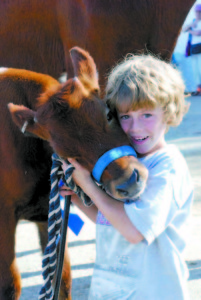Study shows impact of Fryeburg Fair
Fryeburg Fair, which opens this coming Sunday, Oct. 2, recently received the results of an economic impact study conducted in 2015.
Thanks to inspiration from The Big E, aka Eastern States, in Springfield, Mass., Fryeburg Fair hired the Maine Center for Business & Economic Research at University of Southern Maine. led by Ryan Wallace, Project Director, to investigate the Fair’s influence on the local economy.
Wallace led a team of nine students, either pursuing or holding their master’s degrees, to design and implement the project for Fryeburg Fair. It took about six months to complete. The MCBER team spent all eight days at the Fair in 2015. They conducted interviews and surveys to help assess and discover the economic inner workings of Maine’s largest agricultural fair.
Fair employees had done preliminary legwork to prepare for their arrival most notably a questionnaire for campers. With over 3,000 campsites, many occupied by loyal fairgoers returning year after year for generations.
The MCBER also surveyed Fair vendors, exhibitors, residents who parked cars and local businesses. They went into the Bridgton area, Conway and North Conway to interview owners and managers of hotels and restaurants to investigate their impact and benefit from Fryeburg Fair.
As well, their work included research on year-round fair activity. Organizations that utilize the fairgrounds, such as The Good Sam’s Club, the Home, Garden & Flower Show and the summer flea markets, were interviewed. A 50-mile radius was analyzed to answer the question of financial impact and more.
Roy Andrews, the president of Fryeburg Fair says, “We listened to The Big E (Eastern States) discuss this process at the Maine Association of Agricultural Fairs’ annual convention after completing their own financial impact study. They make a huge positive difference on the Springfield, Massachusetts area. We wanted to know the information here in Fryeburg. We also wanted to know more about our average fairgoer so we can plan and manage better.â€
The results, about $18 million of new spending per year in these parts is generated by Fryeburg Fair. This translates to 420 jobs and $1.2 million in sales and income taxes to the states of Maine and New Hampshire annually.
With a 10-year average of 164,400 paid attendees (this does not include children under 12, lifetime pass holders or senior citizens who are free on Tuesday), the #1 fan of Fryeburg Fair averages 55–65 years old and comes from outside the region. These travelers are coming specifically to attend Fryeburg Fair. They spend an average of about $67 per person per day to get to the Fair, for food and drink, parking and accommodations. Once they arrive, they spend another $72 (on average) on additional food and drink, entertainment and retail purchases. It was determined that local residents spend on average of $65 per day.
The study concluded that Fryeburg Fair has an exceptional level of repeat customers, with over 85% of those surveyed returning regularly year after year.
Andrews, always proud of Fryeburg Fair’s history and success, is quick to point out that the 2015 History Hall guest registry documented visitors from all 50 states and 17 countries including England, Poland, Germany, New Zealand and the Dominican Republic.
The top three attractions at the Fair — animals and agriculture, the food and the exhibits. The horses and pulling ranked #1 in the animal exhibits. Night shows were the top favorites in entertainment. Steve’s French Fries and French fries in general were the #1 food choice at the Fair followed by pizza, Emily’s Restaurant, seafood, sausage, apple crisp and doughnuts.
“According to this study, in the last ten years it means we have helped generate $172 million for this area. That’s an impressive number,†Andrews said. “We couldn’t do it without the hundreds of people involved in running and operating the Fair. After 166 years, it is a privilege as well as an obligation to continue our tradition of supporting and highlighting Maine farming and agriculture. We intend to do so with enthusiasm.â€
“Fryeburg Fair has a very sizable economic impact on the region,†concludes Ryan Wallace. “Drawing a large share of attendees from outside the region, the fair attracts significant spending to area businesses and within the fair itself that might not otherwise have occurred. That spending supports jobs and in turn other local businesses. Many local shops depend on the business garnered during the week of the fair for their survival.â€
On a personal note Wallace adds, “I grew up near and going to the Eastern States Exposition in Massachusetts as a kid. It’s hard to top the size and scale of things offered at the Big E, though I can say that when it comes to a traditional agricultural fair feel, Fryeburg is the place to be. In my personal opinion, the fair has some of the best animal exhibits around and is a key reason why people attend. There is lot of diversity in the vendors and things for people to do. I think that’s reflected in the number of folks that have grown up and attended year after year. The Fryeburg Fair is an institution in Maine and northern New England. As the world continues to change, it will be important for the Fair to continue its mission of bringing people together and passing along traditions, while providing an educational opportunity for folks to learn about life on the land and our most important natural resources.â€


